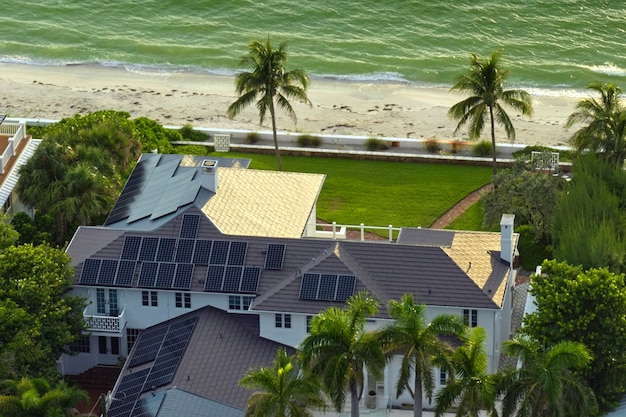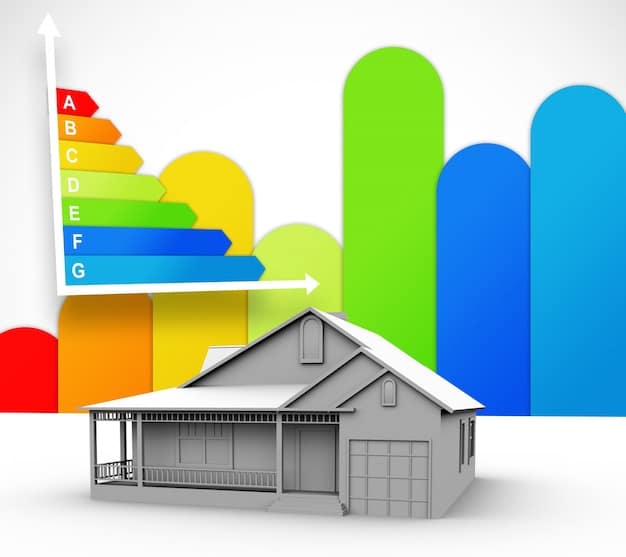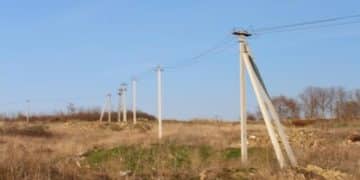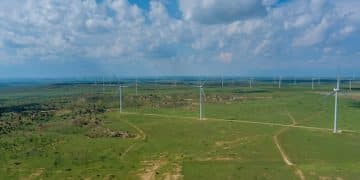Demand Response Programs: A Guide for US Energy Storage Owners

Understanding Demand Response Programs (DRPs) is crucial for US energy storage owners seeking to optimize energy usage and significantly reduce peak demand charges by leveraging stored energy during peak consumption periods.
Are you a US energy storage owner looking to cut down on peak demand charges? Understanding Demand Response Programs: How US Energy Storage Owners Can Reduce Peak Demand Charges can unlock substantial savings and contribute to a more stable and efficient energy grid.
What are Demand Response Programs?
Demand response programs are initiatives designed to incentivize consumers to reduce their electricity consumption during peak demand periods. These programs help to stabilize the grid, prevent blackouts, and lower overall energy costs. For energy storage owners, DRPs present a unique opportunity to generate revenue and optimize their energy assets.
By participating in DRPs, energy storage owners can discharge their stored energy back into the grid when demand is high, effectively reducing the strain on the system. This not only benefits the grid but also provides financial rewards for those who participate.
Types of Demand Response Programs
DRPs come in various forms, each with its own set of rules and incentives. Understanding these different types is essential for choosing the right program for your energy storage system.
- Incentive-Based Programs: These programs offer direct financial incentives for reducing energy consumption during peak hours. Participants receive payments based on their energy savings.
- Time-Based Programs: These programs involve adjusting energy usage based on time-of-use rates or critical peak pricing. Consumers are charged different rates depending on the time of day.
- Direct Load Control Programs: In these programs, the utility has the ability to remotely control certain appliances or equipment to reduce demand during peak periods.

For energy storage owners, incentive-based and time-based programs are often the most attractive options. These programs allow you to leverage your stored energy to maximize savings and revenue. By carefully monitoring energy prices and grid conditions, you can strategically discharge your battery to take advantage of peak demand opportunities. Participating in DRPs is a great way to optimize using Understanding Demand Response Programs: How US Energy Storage Owners Can Reduce Peak Demand Charges.
Benefits of Demand Response for Energy Storage Owners
Participating in demand response programs offers many advantages for energy storage owners. From reducing peak demand charges to generating revenue, the benefits can be substantial.
One of the primary benefits is the ability to lower your overall energy costs. By strategically managing your energy consumption and discharging your battery during peak demand periods, you can avoid high peak demand charges and take advantage of lower off-peak rates.
Financial Incentives
Many DRPs offer financial incentives for participating. These incentives can come in the form of direct payments, bill credits, or other financial rewards. By participating in these programs, you can generate a significant revenue stream from your energy storage system.
In addition to direct financial incentives, DRPs can also help you optimize your energy usage and reduce waste. By carefully monitoring your energy consumption and adjusting your usage patterns, you can identify areas where you can save energy and lower your overall costs.
- Reduced Peak Demand Charges: By discharging your battery during peak demand periods, you can significantly reduce your peak demand charges.
- Revenue Generation: Many DRPs offer financial incentives for participating, allowing you to generate revenue from your energy storage system.
- Grid Stability: By participating in DRPs, you contribute to the stability of the grid and help prevent blackouts.
Ultimately, participating in demand response programs is a win-win situation for energy storage owners. You can reduce your costs, generate revenue, and contribute to a more stable and efficient energy grid when Understanding Demand Response Programs: How US Energy Storage Owners Can Reduce Peak Demand Charges.
How Energy Storage Systems Work in Demand Response
Energy storage systems play a crucial role in demand response programs by providing a flexible and reliable source of power when it’s needed most. These systems can store energy during off-peak hours and discharge it back into the grid during peak demand periods, helping to reduce strain on the system and lower overall costs.
To effectively participate in demand response programs, it’s important to understand how your energy storage system works and how it can be integrated into the grid. This includes understanding the system’s capacity, charge and discharge rates, and communication capabilities.
Optimizing Energy Usage
One of the key aspects of using energy storage in demand response is the ability to optimize energy usage. By carefully monitoring energy prices and grid conditions, you can strategically charge and discharge your battery to maximize savings and revenue.
For example, you can charge your battery during off-peak hours when energy prices are low and discharge it during peak hours when prices are high. This allows you to arbitrage the difference in prices and generate a profit.
- Peak Shaving: Discharging stored energy during peak demand periods to reduce peak demand charges.
- Load Shifting: Shifting energy consumption from peak hours to off-peak hours to take advantage of lower rates.
- Frequency Regulation: Providing real-time frequency regulation services to the grid to maintain stability.

Integrating your energy storage system into demand response programs requires careful planning and coordination. You need to work closely with your utility or grid operator to ensure that your system is properly configured and that you are meeting all of the program requirements. You must consider all aspects of Understanding Demand Response Programs: How US Energy Storage Owners Can Reduce Peak Demand Charges.
Steps to Participate in Demand Response Programs
Participating in demand response programs can seem daunting at first, but with the right knowledge and preparation, it can be a straightforward process. Here are the key steps to get started:
First, you need to research and identify the DRPs that are available in your area. Contact your local utility or grid operator to learn about the different programs that they offer and the eligibility requirements. You may also find information online or through industry associations.
Evaluating Program Requirements
Once you have identified the available programs, carefully evaluate the requirements and determine which ones are the best fit for your energy storage system. Consider factors such as the program’s incentives, participation requirements, and potential risks.
It’s also important to assess your energy storage system’s capabilities and ensure that it can meet the program’s requirements. This includes evaluating the system’s capacity, charge and discharge rates, and communication capabilities.
- Research Available Programs: Contact your local utility or grid operator to learn about available DRPs.
- Assess Your Energy Storage System: Evaluate your system’s capabilities and ensure that it can meet the program requirements.
- Enroll in a Program: Submit an application and provide the necessary documentation to enroll in the program.
After you have enrolled in a program, you will need to monitor your energy consumption and adjust your usage patterns to meet the program’s requirements. This may involve reducing your energy consumption during peak hours, discharging your battery back into the grid, or adjusting your equipment settings to optimize energy usage. Taking these steps is key to Understanding Demand Response Programs: How US Energy Storage Owners Can Reduce Peak Demand Charges.
Challenges and Considerations
While demand response programs offer many benefits, there are also some challenges and considerations that energy storage owners should be aware of. These include regulatory hurdles, technical limitations, and market uncertainties.
One of the main challenges is navigating the complex regulatory landscape. DRPs are often governed by state and federal regulations, which can vary widely depending on the location. It’s important to stay up-to-date on the latest regulations and ensure that your system is compliant.
Technical Limitations
Another challenge is dealing with technical limitations. Energy storage systems have finite capacity and charge/discharge rates, which can limit their ability to participate in DRPs. It’s important to carefully manage your system’s resources and ensure that you are meeting the program’s requirements.
Market uncertainties can also pose a challenge. Energy prices and grid conditions can fluctuate rapidly, making it difficult to predict the optimal time to charge and discharge your battery. This requires careful monitoring and analysis.
- Regulatory Hurdles: Navigating complex state and federal regulations.
- Technical Limitations: Managing the finite capacity and charge/discharge rates of energy storage systems.
- Market Uncertainties: Dealing with fluctuating energy prices and grid conditions.
Despite these challenges, the benefits of participating in demand response programs often outweigh the risks. By carefully planning and managing your energy storage system, you can overcome these challenges and unlock substantial savings and revenue. Learning how is a major part of Understanding Demand Response Programs: How US Energy Storage Owners Can Reduce Peak Demand Charges.
The Future of Demand Response and Energy Storage
The future of demand response and energy storage is bright, with increasing adoption of renewable energy and growing awareness of the benefits of grid flexibility. As more consumers and businesses install energy storage systems, the potential for demand response programs will continue to grow.
One of the key trends driving this growth is the increasing deployment of distributed energy resources (DERs), such as solar panels and wind turbines. These resources can generate clean energy on-site, reducing the need for centralized power plants.
Emerging Technologies
Emerging technologies, such as advanced battery management systems and smart grid technologies, are also playing a key role. These technologies enable more efficient and reliable operation of energy storage systems, making them more attractive for demand response programs.
In the future, we can expect to see more sophisticated and integrated demand response programs that leverage the full potential of energy storage systems. These programs will be able to respond to real-time grid conditions and optimize energy usage across entire communities.
- Increased Adoption of Renewable Energy: Growing deployment of solar panels and wind turbines.
- Emerging Technologies: Advanced battery management systems and smart grid technologies.
- More Sophisticated Programs: Integrated demand response programs that optimize energy usage across communities.
Ultimately, the future of demand response and energy storage is about creating a more sustainable, resilient, and efficient energy grid. By participating in these programs, energy storage owners can be part of the solution and help shape the future of energy. Knowing the future of energy solutions is a part of Understanding Demand Response Programs: How US Energy Storage Owners Can Reduce Peak Demand Charges.
| Key Aspect | Brief Description |
|---|---|
| 💡 DRP Definition | Incentive programs to reduce electricity use during peak times. |
| 💰 Financial Benefits | Reduces peak demand charges and generates revenue through incentives. |
| 🔋 Energy Storage Role | Provides flexible power by storing energy off-peak and discharging during peak demand. |
| 🌱 Future Trends | Growing adoption of renewables and smart grid technologies. |
FAQ Section
▼
Peak demand charges are fees imposed by utilities based on the highest amount of electricity consumed during a billing cycle. Reducing peak demand lowers these costs. Understanding peak demand charges is a key part of Understanding Demand Response Programs: How US Energy Storage Owners Can Reduce Peak Demand Charges.
▼
Energy storage systems store electricity during off-peak hours and discharge it during peak hours, reducing the amount of electricity drawn from the grid when demand is highest and preventing inflated peak demand charges.
▼
Battery storage systems like lithium-ion batteries are ideal due to their fast response times and high efficiency. Other options include flow batteries and thermal energy storage, depending on specific needs.
▼
Key requirements include having a compatible energy storage system, meeting minimum capacity requirements, and adhering to the program’s specific operational guidelines set by the utility or grid operator.
▼
Start by contacting your local utility or grid operator to inquire about available DRPs. Assess your energy storage system’s capabilities, and evaluate which programs best fit your needs and operational parameters.
Conclusion
Understanding Demand Response Programs: How US Energy Storage Owners Can Reduce Peak Demand Charges is essential in today’s energy landscape. By participating in these programs, you can reduce your energy costs, generate revenue, and contribute to a more sustainable and resilient energy grid. As the adoption of renewable energy and energy storage continues to grow, demand response programs will play an increasingly important role in shaping the future of energy.





